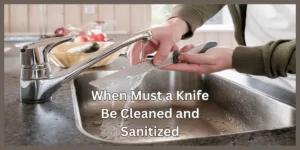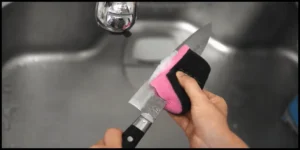When Must a Knife Be Cleaned and Sanitized? Best Guide Of 2024
Knowing when must a knife be cleaned and sanitized is essential for maintaining food safety and preventing contamination in the kitchen. Whether you’re a home cook or a professional chef, understanding how and when to clean and sanitize your knives will protect against bacteria and foodborne illnesses.
This article explains the crucial times when a knife must be cleaned and sanitized, how to do it correctly, and the studies supporting these practices.
Here Is When Must a Knife Be Cleaned and Sanitized

Proper knife sanitation is critical to prevent the spread of bacteria and foodborne pathogens, which can lead to health risks.
Studies have shown that cross-contamination in the kitchen is one of the leading causes of foodborne illness. Knowing when must a knife be cleaned and sanitized is a simple yet essential part of kitchen hygiene.
In addition, unsanitized knives can harbour residues that affect the flavour and quality of your food.
By following proper cleaning and sanitization practices, you ensure that your ingredients remain uncontaminated, resulting in safer and tastier meals.
When Must a Knife Be Cleaned and Sanitized? Key Times to Know
Here are specific instances when a knife must be cleaned and sanitized to ensure safety:
1. After Cutting Raw Meat, Poultry, or Seafood
One of the most critical times when a knife must be cleaned and sanitized is after cutting raw proteins like meat, poultry, or seafood. These foods can carry harmful bacteria such as Salmonella, E. coli, and Listeria. Cleaning and sanitizing your knife after handling raw meat prevents the transfer of these pathogens to other ingredients.
2. When Switching Between Different Food Types
Cross-contamination is a common issue in kitchens. Therefore, when a knife must be cleaned and sanitized is any time you switch between food types, such as going from raw meat to vegetables or cooked food. This practice prevents the risk of transferring bacteria from one type of food to another.
3. Before and After Using a Knife for Ready-to-Eat Foods
Another key moment when a knife must be cleaned and sanitized is before and after using it for ready-to-eat foods, such as fruits, salads, or sandwiches. Since these foods are not cooked, any contamination could directly affect your health.
4. After Cutting Foods with Strong Odors or Colors
Foods like onions, garlic, and beets can leave residual odours or colours on the knife. In such cases, when a knife must be cleaned and sanitized is immediately after cutting these items, they don’t transfer to other foods, affecting flavour and appearance.
5. At the End of Each Cooking Session
Even if your knife appears clean, sanitizing it at the end of every cooking session is a good habit. Knowing when a knife must be cleaned and sanitized at the end of cooking prevents bacterial buildup and keeps your kitchen tools hygienic for future use.
When Must a Knife Be Cleaned and Sanitized
Research has shown the importance of regular cleaning and sanitizing of kitchen tools. A study published in Food Control found that cross-contamination is significantly reduced by cleaning knives between uses, particularly when switching between raw and cooked foods. Knowing when a knife must be cleaned and sanitized minimizes the transfer of harmful bacteria and enhances food safety.
Another study by the Journal of Food Protection analyzed the survival of bacteria on kitchen surfaces and tools, concluding that regular sanitization of knives effectively removes pathogens. These findings highlight the importance of understanding when must a knife be cleaned and sanitized to maintain a safe cooking environment.
How to Properly Clean and Sanitize a Knife

Now that we understand when a knife must be cleaned and sanitized, let’s look at the proper methods to ensure effective cleaning.
- Rinse with Warm, Soapy Water: After use, rinse the knife with warm, soapy water to remove food residues. This is especially important when a knife must be cleaned and sanitized after handling raw meat or strong-smelling foods.
- Sanitize with a Bleach Solution: For deeper sanitization, especially after handling raw proteins, dip the knife in a bleach solution (1 tablespoon of bleach per gallon of water). Doing this step ensures thorough cleaning when a knife must be cleaned and sanitized after potentially hazardous foods.
- Dry Immediately: Dry the knife thoroughly after cleaning and sanitizing. Leaving it wet can cause bacteria growth and rust.
- Store Properly: Proper storage also helps maintain cleanliness. Ensure that knives are stored in a clean, dry area to avoid contamination. This practice complements the times when a knife must be cleaned and sanitized, keeping it ready for safe use.
Tips for Maintaining Hygiene in the Kitchen
Knowing when a knife must be cleaned and sanitized is only one part of maintaining a safe kitchen. Here are additional tips to enhance kitchen hygiene:
- Use Separate Knives for Different Foods: Using different knives for meat, vegetables, and ready-to-eat foods can reduce the need for frequent cleaning and prevent cross-contamination.
- Clean Cutting Boards Regularly: Cross-contamination can also occur through cutting boards. Be sure to clean and sanitize them along with your knives.
- Develop a Routine: Establish a cleaning and sanitizing routine to maintain all kitchen tools, including knives, properly. A regular schedule helps you remember when must a knife be cleaned and sanitized for optimal safety.
Conclusion: When Must a Knife Be Cleaned and Sanitized?
Understanding when must a knife be cleaned and sanitized is essential for anyone serious about kitchen hygiene and food safety. Properly cleaning and sanitizing your knife after handling raw meat, switching between food types, or cutting ready-to-eat foods can prevent foodborne illnesses. The answer to when a knife must be cleaned and sanitized is simple: clean it whenever there’s a risk of contamination.
Studies underscore the importance of knowing when must a knife be cleaned and sanitized as a way to reduce the spread of harmful bacteria. By practising safe knife sanitization, you’re ensuring that your kitchen is a clean, safe space for meal preparation.
Sources:
- Food Control Journal: “Effect of Regular Knife Cleaning on Cross-Contamination in Kitchen Environments”
- Journal of Food Protection: “The Impact of Knife Sanitization on Reducing Bacterial Spread in Commercial Kitchens”
Read Also This: What is the Best Steel for Kitchen Knives: A Comprehensive Guide - 2024
Leave a Reply